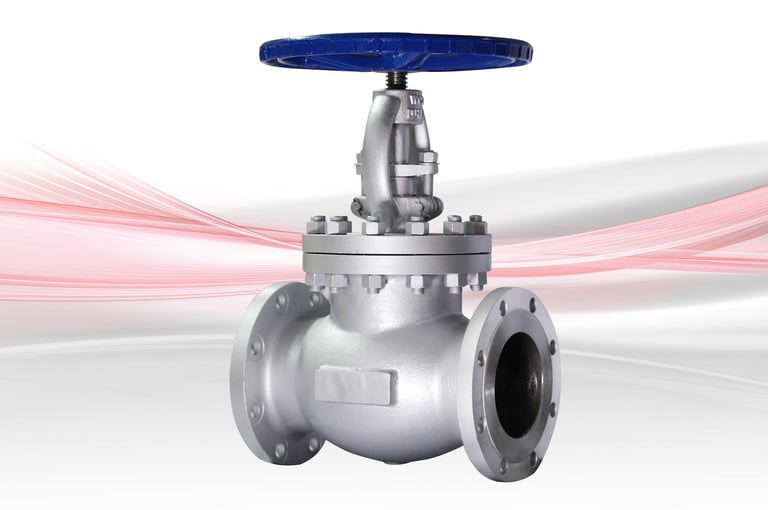Globe Valves


Globe valves are widely used for regulating flow in pipelines, making them ideal for applications where throttling is needed. Their design allows for precise control of flow, pressure, and temperature. Below are the details and specifications for globe valves:
1. Size Range:
Typically available in sizes from 1/2" to 24" (DN 15 to DN 600).
Larger sizes can be custom made depending on the application.
2. Pressure Ratings:
Pressure classes generally range from 150# to 2500# (PN 10 to PN 420).
Valves with higher pressure ratings are available for high-pressure applications in power generation, chemical, and oil & gas industries.
3. Material Specifications:
Body Materials:
Carbon Steel: ASTM A216 WCB (for general-purpose applications)
Stainless Steel: 304, 304L, 316, 316L (for corrosive environments)
Alloy Steel: ASTM A217 WC6, WC9, C12 (for high-temperature services)
Bronze and Brass: Used in smaller sizes and lower-pressure applications.
Duplex & Super Duplex Stainless Steel: For highly corrosive or high-pressure applications.
Monel, Inconel, Hastelloy, Titanium: For specialized, highly corrosive or high-temperature applications.
Seating Materials:
Metal Seats: For high-temperature and high-pressure applications.
Soft Seats: PTFE, Teflon, or other polymers for tight sealing in lower pressure or non-abrasive services.
4. Valve Design Types:
T-Pattern Globe Valve (Z-type): The most common type with the lowest pressure drop. Suitable for on/off or throttling services.
Y-Pattern Globe Valve: Offers less flow resistance and is used for applications where pressure drop is a concern.
Angle Pattern Globe Valve: Allows a 90-degree change in flow direction, typically used for applications involving pulsating flows or where space is limited.
5. Flow Characteristics:
Globe valves provide linear flow characteristics, allowing precise control over fluid flow. The design ensures that the valve opens gradually, making it suitable for throttling.
The flow direction is generally over the disc for low-pressure applications and under the disc for high-pressure applications to reduce damage to the disc and seat.
6. End Connections:
Flanged Ends: ASME, ANSI, DIN, and EN standards.
Threaded Ends: NPT, BSP, BSPT, and BSPP threads are available for smaller valves.
Butt Weld Ends: Used in high-pressure or high-temperature applications.
Socket Weld Ends: For smaller, high-pressure applications.
7. Bonnet Types:
Bolted Bonnet: The most common design, suitable for a wide range of applications.
Welded Bonnet: Used in high-pressure or high-temperature environments where leak-tightness is critical.
Pressure-Seal Bonnet: Often used for high-pressure applications, such as in power plants, where the internal pressure helps seal the valve.
Union Bonnet: Common in smaller-sized valves for ease of maintenance.
8. Stem and Disc Designs:
Rising Stem with Non-Rotating Disc: Common in throttling services, allows precise control.
Non-Rising Stem: Suitable for areas with space constraints, often used in underground or confined installations.
Disc Types:
Plug Disc: Provides tight shutoff and is suitable for on/off service.
Needle Disc: Allows fine throttling and is used in smaller valves for precise flow control.
Ball Disc: Provides good shutoff capabilities with minimal leakage.
9. Applications:
Throttling Services: Ideal for regulating flow in applications where precise control over flow is necessary, such as in cooling water systems, steam applications, or fuel oil systems.
On/Off Services: Can also be used for isolation when tight shutoff is required.
High-Temperature and High-Pressure Applications: Globe valves are widely used in power generation plants, oil refineries, chemical processing, and other high-temperature and high-pressure industries.
Corrosive Fluids: Stainless steel and special alloy globe valves are used for handling corrosive media in chemical and petrochemical industries.
Cryogenic Applications: Specialized designs with extended bonnets are available for cryogenic services.
QUALITY
Supplying High-Quality Plates, Wire Mesh, perforated Sheets, Coils, All types of Flanges, Round Bars, Fasteners, Vales, Strainers etc.
Contact us
Request a quote
✉️ Email:
admin@mw-enterprises.com
abdulwahab.ansari@mw-enterprises.com
📞 Phone: +91 90281 70158
MW Enterprises © 2024. All rights reserved. Developed by Seofy.in
Our sales & supply are in below countries:
Saudi Arabia, Qatar, Oman, Kuwait, United Arab Emirates (UAE), Dubai, Bahrain, Italy, Indonesia, Malaysia, Jordan, Sri Lanka, Vietnam, South Africa
Abdul Wahab Ansari
MW Enterprises General Trading Company
